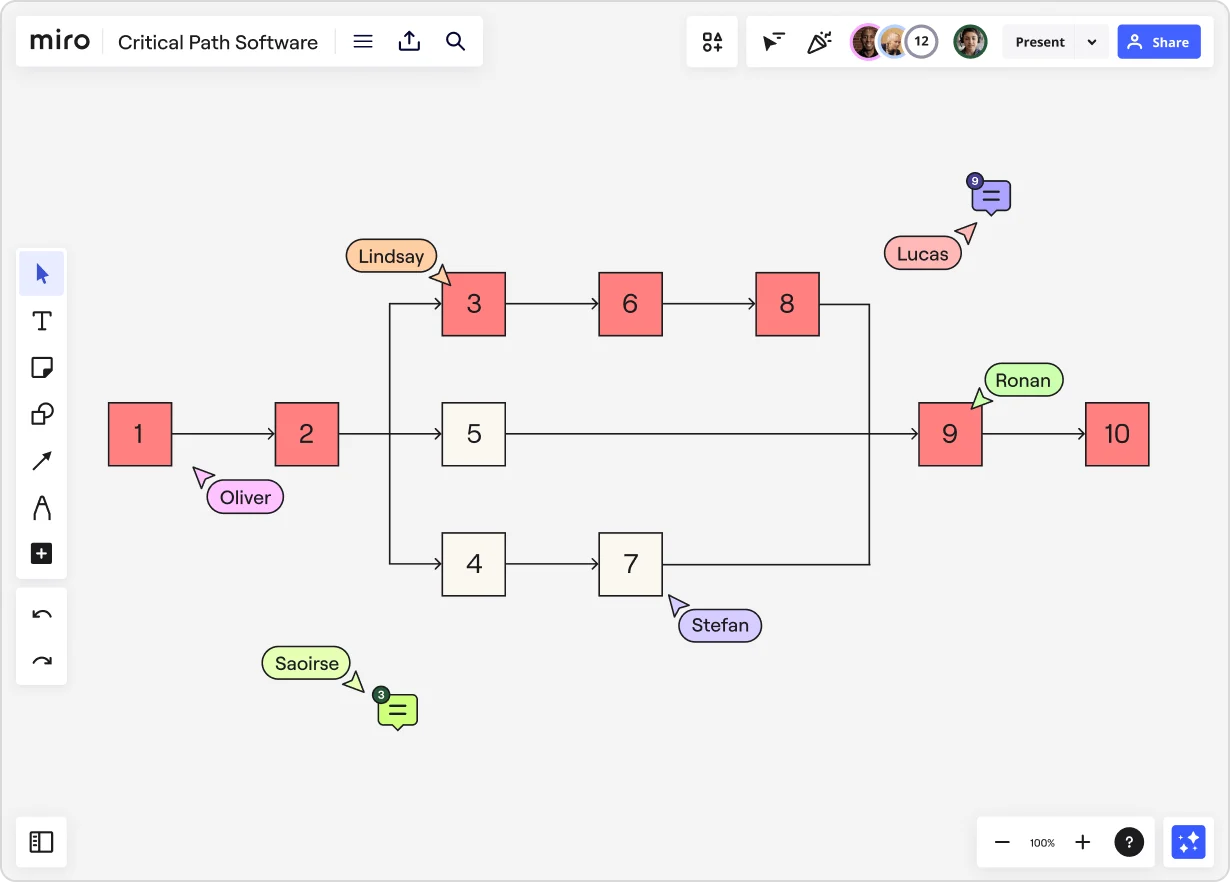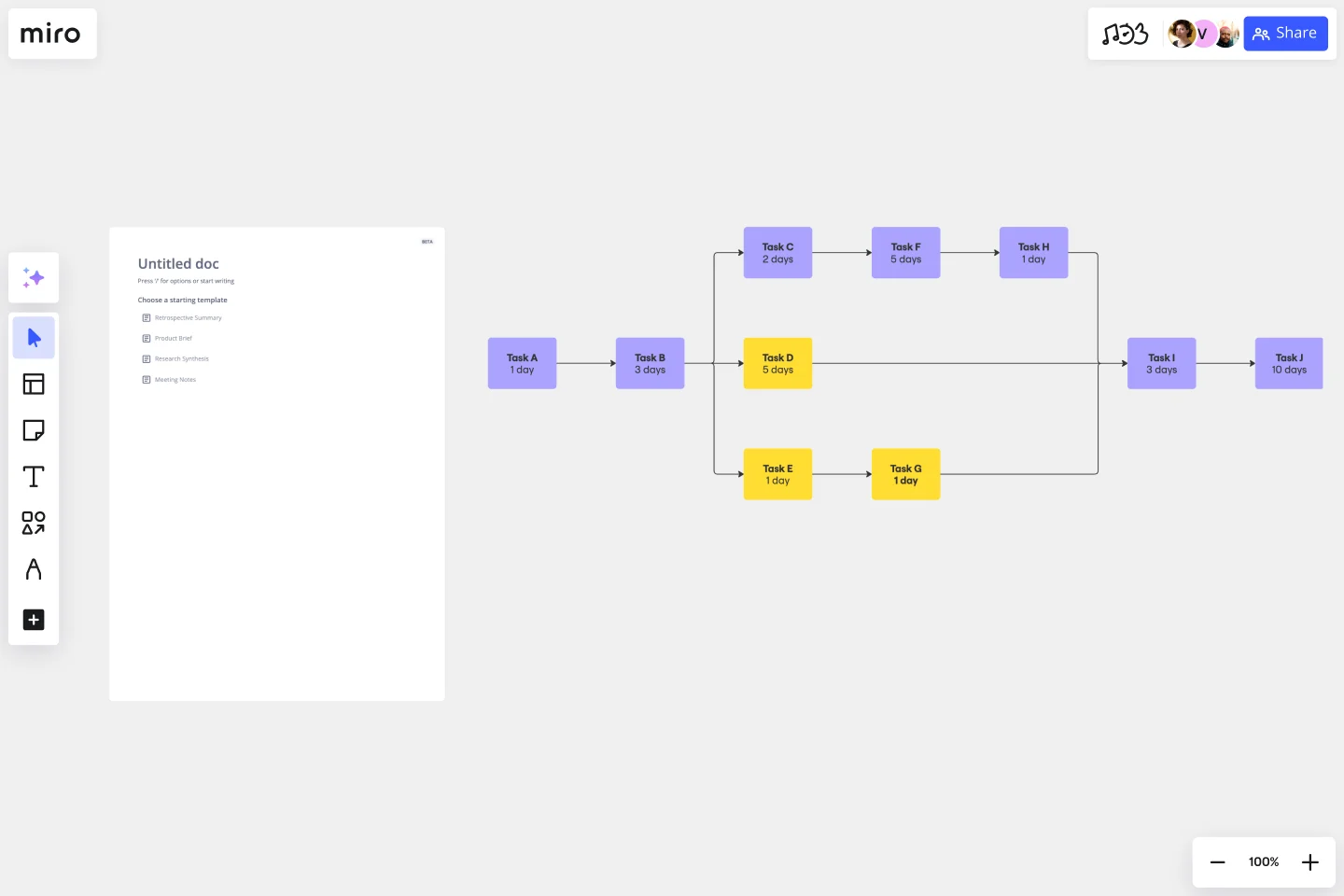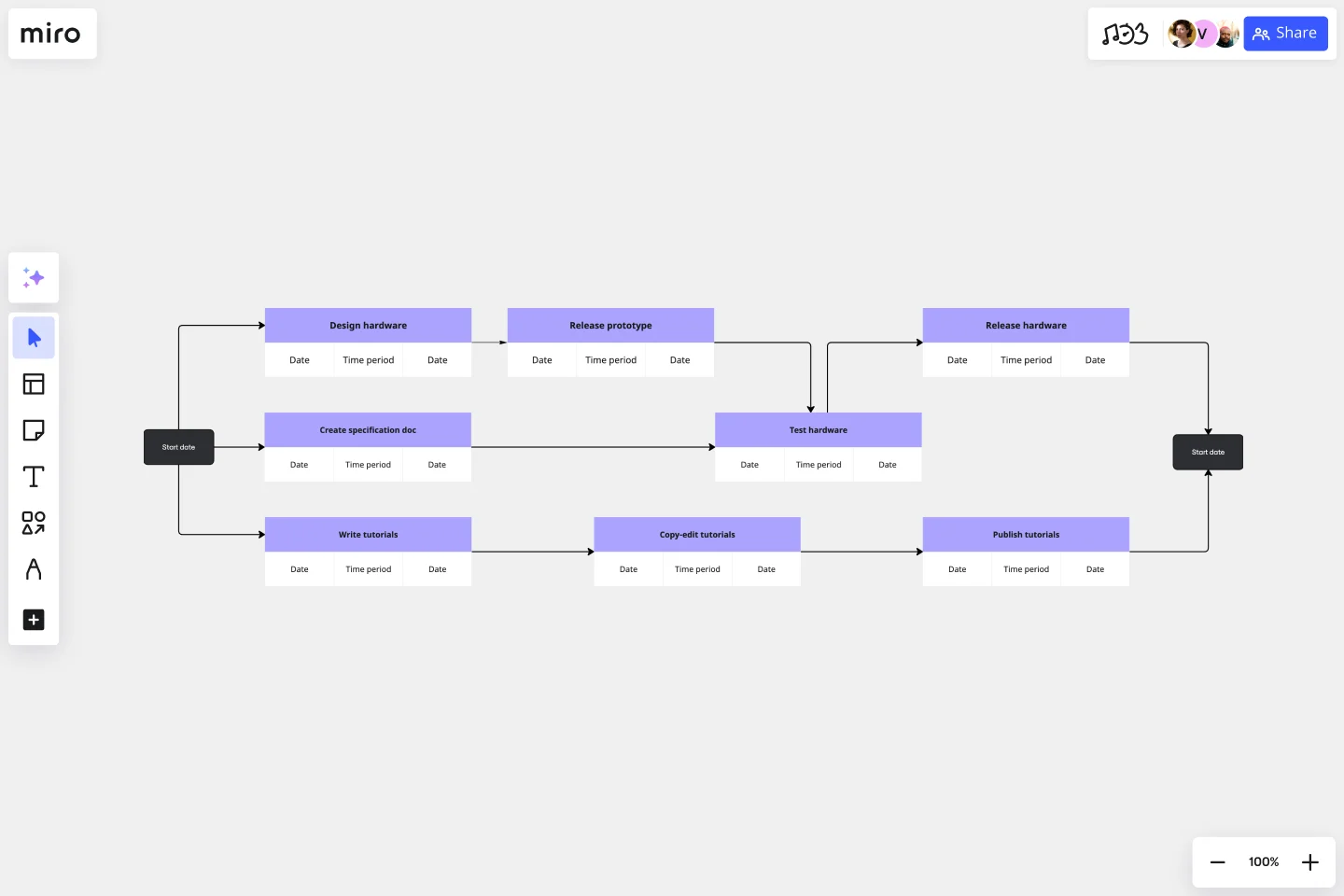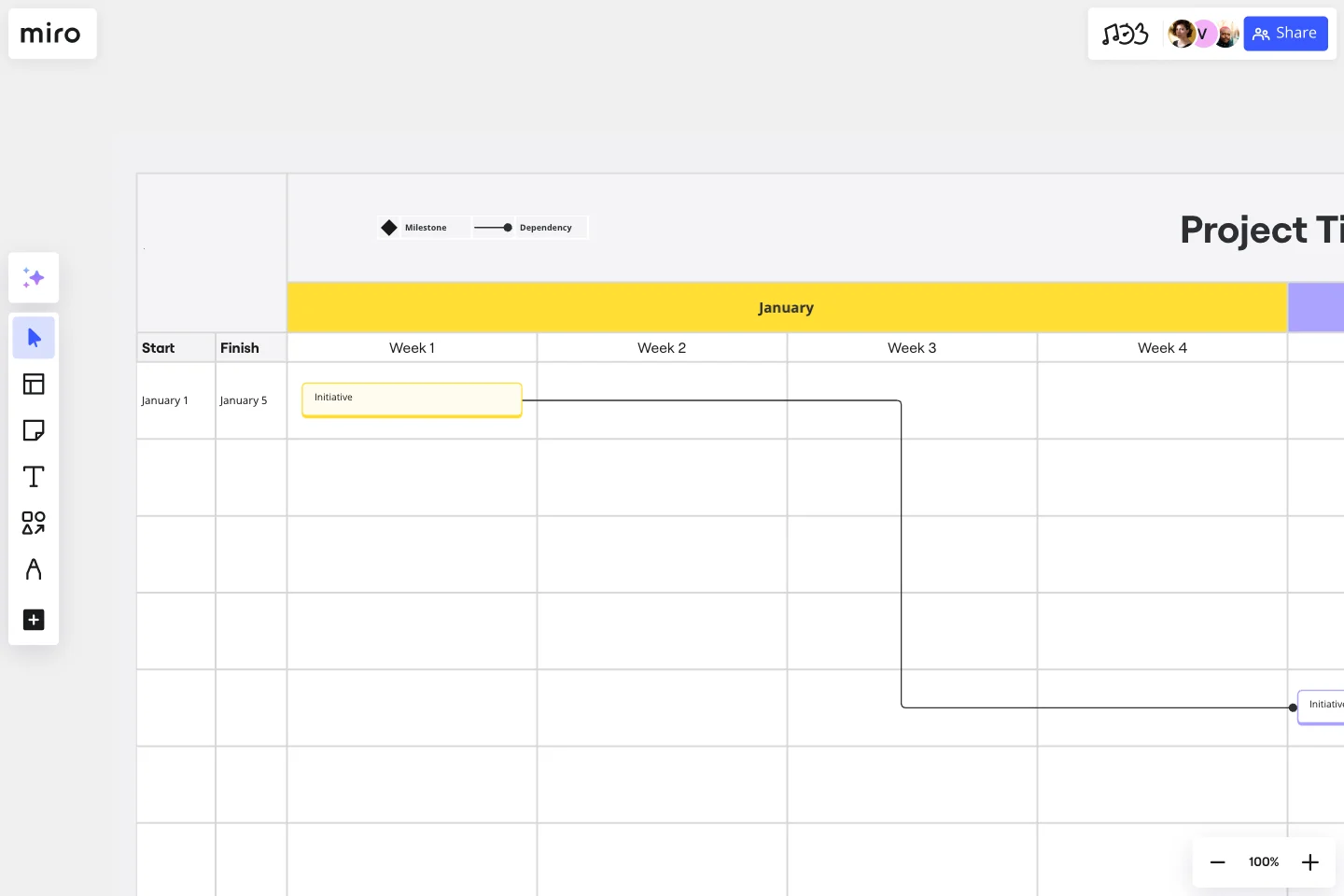
Table of contents
Table of contents
What is the critical path method?

Summary
In this guide, you will learn:
What CPM is and its role in minimum project duration
Key steps in applying CPM, including defining activities, identifying dependencies, and creating a network diagram
How CPM helps identify critical and non-critical tasks
The origins of CPM and its evolution
How CPM aids in resource allocation, risk mitigation, and improving project communication
Practical examples of CPM application
Try Miro now
Join thousands of teams using Miro to do their best work yet.
The critical path method (CPM) is a project management technique that helps professionals streamline workflows, anticipate delays, and ensure timely project completion. By identifying the sequence of critical tasks that will determine the project's timeline, CPM enables teams to focus resources and attention on the tasks that matter most.
Let's dig into the essentials of CPM, why it's beneficial for complex projects, and how to use it effectively to improve project timelines and resource management.
Understanding the critical path method

Miro's critical path template While the critical path method might sound complicated, it's fundamentally about mapping out each task in a project to see how they relate, depend on one another, and contribute to the project's timeline. This gives project managers a clear, strategic view of the project's most critical tasks.
Definition of the critical path method
At its core, the critical path method identifies the longest sequence of dependent tasks, called the "critical path," which determines the minimum time required to complete a project. If any task on this path is delayed, the entire project timeline will be affected. By understanding the critical path, project managers can anticipate potential bottlenecks and focus on the tasks that matter most for timely project delivery.
Essential components of the CPM
To effectively apply CPM, it's essential to understand its foundational components:
Tasks or Activities: The individual steps required to complete the project, ranging from simple to complex tasks, each with a defined start and end point.
Dependencies: Relationships between tasks that dictate the sequence they need to occur. For example, some tasks may need to be completed before others can begin.
Duration: The estimated time required to complete each task, which impacts the project's timeline. Accurate estimation is key in determining the critical path.
Critical Path: The sequence of dependent tasks with the longest cumulative duration, which defines the project's minimum completion time.
Float (or Slack): Float indicates how much a task can be delayed without affecting the project's overall timeline. Tasks on the critical path have zero float, making them highly time-sensitive.
How does the critical path method work? A quick guide
Let's look at the detailed step-by-step process for using CPM to manage a project effectively. Each step builds on the previous one, helping you create a clear roadmap for even the most complex projects.
Step-by-step process of the CPM
1. List all tasks: Begin by identifying every task required to complete the project. This list should be as detailed as possible to ensure nothing critical gets overlooked. Think about each phase of the project and break it down into individual tasks or activities. Every task needs to be accounted for, whether it's a major milestone or a small, support task.
2. Determine task dependencies: Once you have a list of tasks, identify dependencies between them. Dependencies define the relationships between tasks and help determine the sequence in which tasks need to be performed. For example, if Task B can only start after Task A is completed, Task A is a dependency for Task B. Mapping out dependencies will allow you to see which tasks can run concurrently and which ones must follow a specific order.
3. Estimate the duration of each task: Now it's time to estimate the time required to complete each task. Duration estimates should be as realistic as possible. If you're unsure about specific task durations, consult team members or use historical data from past projects for reference. Duration estimates directly impact the critical path, so it's worth taking the time to get these as accurate as possible.
4. Develop a project schedule: With your tasks, dependencies, and durations in hand, you can create a preliminary schedule. This often involves laying out the tasks in sequence, noting their dependencies, and estimating the overall project timeline. Visualizing this schedule with a network diagram, flowchart, or timeline helps to see the flow of tasks and how they're interconnected.
5. Identify the critical path: The critical path is the sequence of dependent tasks with the longest duration. This is your project's backbone — any delay in this sequence will delay the entire project. To find the critical path, start by calculating the earliest start and finish times for each task, working from the beginning to the end of the project. Then, calculate the latest start and finish times, working backward. Tasks with zero float are on the critical path.
6. Monitor and adjust as needed: Throughout the project, monitor tasks on the critical path to ensure they're on schedule. If any task on the critical path is delayed, you'll need to either reallocate resources, adjust deadlines, or potentially adjust the project's scope to keep the project on track. Regularly reviewing the critical path can help you catch issues early and make informed adjustments to avoid timeline disruptions.
Why and when should you use the critical path method?
CPM is particularly valuable for projects with multiple phases, complex task dependencies, or tight timelines. Here's when CPM becomes especially useful:
Complex projects with numerous tasks: For projects involving multiple tasks that depend on each other, CPM helps visualize task dependencies, set priorities, and keep the project organized.
Projects with strict deadlines: When a project has a firm completion date, CPM can help managers track every task to stay on schedule. By focusing on the critical path, managers know which tasks to prioritize and avoid delays.
Resource allocation and optimization: When resources (like team members or budgets) are limited, CPM can help managers allocate them more effectively, concentrating on tasks that directly impact the project timeline.
Projects that require efficient scheduling: For projects where timing is crucial — such as marketing campaigns, software launches, or event planning — CPM helps break down tasks, allowing managers to schedule them optimally.
Risk management and contingency planning: CPM can serve as an early warning system. By understanding which tasks have float, project managers can identify areas where delays might occur and prepare contingencies.
How to use the critical path method
If you're ready to implement CPM in your project management workflow, here's a general approach to setting it up and ensuring its effectiveness.
1. Map out all tasks and dependencies: Begin by listing every task and mapping out their dependencies. Organizing these visually — with a flowchart or network diagram — will give you a comprehensive view of the project structure, showing which tasks depend on others and which can run concurrently.
2. Calculate duration and assign realistic timelines: Assign a duration estimate to each task. Where possible, base these on historical data or expert estimates to keep timelines realistic. Accurate task durations are essential for determining the critical path.
3. Build your project timeline and highlight the critical path: With your tasks, dependencies, and durations mapped out, you can build your project timeline. Identify the sequence of tasks with the longest duration, marking them as your critical path. This sequence defines the minimum time required to complete the project and helps you see where delays would affect the entire project.
4. Track progress and adjust as needed: Throughout the project, check in on the tasks in your critical path frequently. Any delay in these tasks will push back the project timeline, so it's essential to keep them on schedule. Adjust resources, timelines, or team responsibilities as needed to keep these tasks moving smoothly.
5. Communicate the critical path to the team: The entire project team should understand which tasks are critical to project success. By sharing the critical path with team members, you align everyone around the project's priorities, helping them focus on what's most important to meet deadlines.
Critical path method and other project management techniques
While the critical path method is powerful, it's often compared with other project management tools and techniques like PERT and Gantt charts. Here's how it stacks up:
Critical path vs PERT

The Program Evaluation and Review Technique (PERT) is similar to CPM but with a focus on time variability. While CPM uses one duration estimate per task, PERT assigns three estimates: optimistic, pessimistic, and most likely. This makes PERT ideal for projects where durations are less predictable and vary significantly.
Key difference: CPM is ideal when task durations are relatively predictable. For projects with uncertain timelines, PERT can provide a more flexible approach by accounting for potential variation in task durations.
Critical path vs Gantt chart

A Gantt chart provides a visual representation of tasks on a timeline, showing start and end dates and any overlap between tasks. It's helpful for project managers who want a high-level view of when tasks occur. However, Gantt charts don't easily highlight dependencies or the critical path, making CPM more effective for projects where dependencies play a crucial role.
Key difference: While Gantt charts display timing and overlap well, CPM focuses on dependencies, making it more effective for identifying time-sensitive tasks that affect the project's completion date.
Manage projects effectively: Tips for implementing the critical path method in project management
The critical path method can transform project management when applied effectively. Here are some tips to help you make the most of CPM:
1. Prioritize clarity in task definitions: Ensure that every task is clearly defined. The more precise your tasks, the easier it will be to manage dependencies and schedule durations accurately.
2. Identify dependencies carefully: Dependencies are the backbone of CPM. Clarifying dependencies early on helps you prevent bottlenecks and allows you to develop a realistic project flow.
3. Use accurate time estimates: Time estimation can make or break the effectiveness of CPM. Take time to make your duration estimates as realistic as possible, consulting past projects or subject matter experts if needed.
4. Regularly review the critical path: The critical path can shift as tasks are completed or delayed, so monitor it regularly. Adjust timelines or resources as needed to keep the project on track.
5. Foster team communication around priorities: Encourage team members to communicate frequently about task progress, especially for those on the critical path. By keeping everyone aligned on project priorities, you can reduce misunderstandings and support timely completion.
To streamline this process and improve collaboration, Miro's innovation workspace is a great critical path method tool. With powerful visual project mapping, Miro AI for task analysis, and real time collaboration, Miro supports you every step of the way, keeping complex projects organized and on schedule.
Author: Miro Team
Last update: October 16, 2025